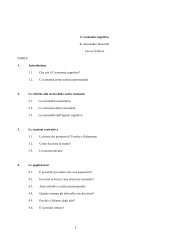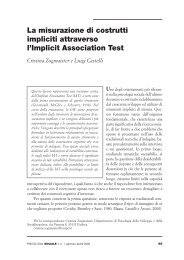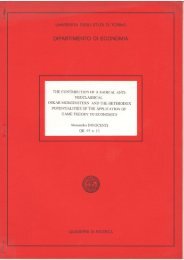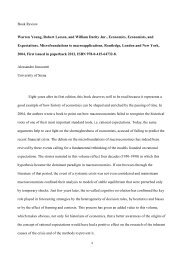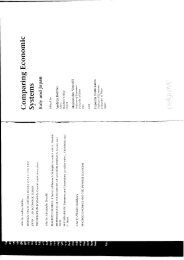The Advantages of Outsourcing in terms of Information ... - LabSi
The Advantages of Outsourcing in terms of Information ... - LabSi
The Advantages of Outsourcing in terms of Information ... - LabSi
Create successful ePaper yourself
Turn your PDF publications into a flip-book with our unique Google optimized e-Paper software.
etween the contractor and the subcontractor is considered unessential and if task assignment is not<br />
different from that concern<strong>in</strong>g various establishments <strong>of</strong> the same hierarchically <strong>in</strong>tegrated firm.<br />
Notwithstand<strong>in</strong>g the persistence <strong>of</strong> arm-lengths relationships, the evidence confirms that the<br />
better performance <strong>of</strong> networks <strong>in</strong> <strong>terms</strong> <strong>of</strong> production quality is correlated to a greater <strong>in</strong>volvement<br />
<strong>of</strong> subcontractors <strong>in</strong> the management <strong>of</strong> <strong>in</strong>formation that also seems to allow another advantage: a<br />
higher and more diffuse rate <strong>of</strong> <strong>in</strong>novation. Empirical f<strong>in</strong>d<strong>in</strong>gs on the effect <strong>of</strong> co-design on product<br />
<strong>in</strong>novation are rather anecdotal, <strong>in</strong> the sense that some case studies <strong>of</strong> firms show higher rate <strong>of</strong><br />
product <strong>in</strong>novation after sett<strong>in</strong>g-up such partnership relationships with co-design. However,<br />
systematic evidence is lack<strong>in</strong>g. At this stage, we can only develop a theoretical argument <strong>in</strong> favour<br />
<strong>of</strong> such hypothesis.<br />
To make clear our argument, we have to recall some general def<strong>in</strong>itions. First, we assume<br />
that knowledge is, to some degree, always tacit, while <strong>in</strong>formation is the only part <strong>of</strong> knowledge<br />
that can be transferred. Knowledge can be considered as an <strong>in</strong>f<strong>in</strong>ite set - ma<strong>in</strong>ly because it is the<br />
outcome <strong>of</strong> a mental process - that <strong>in</strong>cludes <strong>in</strong>formation as a closed set (Fransman, 1994). While<br />
<strong>in</strong>formation can be communicated, knowledge cannot always be communicated perfectly. In other<br />
words, <strong>in</strong>formation is knowledge made explicit that can be communicated to others. <strong>The</strong> process <strong>of</strong><br />
knowledge creation can be described as a sequence where the subject collects <strong>in</strong>formation, that is<br />
explicit knowledge communicated by others, and comb<strong>in</strong>es it with the previously possessed<br />
knowledge, which is both explicit and tacit. <strong>The</strong> outcome is new knowledge that is only partially<br />
communicated to others.<br />
We also assume a specific mean<strong>in</strong>g <strong>of</strong> hierarchy. Aoki (1986) def<strong>in</strong>es hierarchy as "the<br />
layer<strong>in</strong>g <strong>of</strong> specialised decision mak<strong>in</strong>g <strong>in</strong> order to cope with emergent events for which detailed<br />
specification <strong>of</strong> appropriate actions cannot be formulated ex ante". Accord<strong>in</strong>g to this def<strong>in</strong>ition, the<br />
decision maker typically performs the activity <strong>of</strong> manag<strong>in</strong>g by exception. 6 Subord<strong>in</strong>ates are<br />
assumed not be<strong>in</strong>g able to cope with exceptional events. Any problem that is not solvable by<br />
ord<strong>in</strong>ary skills <strong>of</strong> the subord<strong>in</strong>ates is reported to the upper layer who is responsible for f<strong>in</strong>d<strong>in</strong>g the<br />
solution. Consequently, the larger is the range <strong>of</strong> activities assigned to each level <strong>of</strong> the hierarchy,<br />
the higher the number <strong>of</strong> unexpected problems reported to the upper levels.<br />
Hierarchy can also be viewed as a system where "only a few <strong>in</strong>dividuals (or only one<br />
<strong>in</strong>dividual) can undertake projects, while others provide support <strong>in</strong> decision mak<strong>in</strong>g", as opposed to<br />
a polyarchy, i.e. a system <strong>in</strong> which "there are several decision makers who can undertake projects<br />
(or ideas) <strong>in</strong>dependently <strong>of</strong> one another" (Sah and Stiglitz 1986, p. 716). This def<strong>in</strong>ition helps to<br />
compare the <strong>in</strong>tegrated firm, i.e. a self-conta<strong>in</strong>ed hierarchical system, with the decentralised<br />
network, that is a polyarchy where several <strong>in</strong>dependent decision makers autonomously undertake<br />
productive projects. By the same token, if the <strong>in</strong>tegrated firm is the place where all residual rights <strong>of</strong><br />
control accrue to the owner, then the decentralised network can be seen as a system <strong>in</strong> which<br />
multiple owners possess rights <strong>of</strong> control on separate competencies. <strong>The</strong> choice <strong>of</strong> an organisational<br />
pattern can thus be represented as the selection <strong>of</strong> a po<strong>in</strong>t on the l<strong>in</strong>e jo<strong>in</strong><strong>in</strong>g the extreme cases <strong>of</strong><br />
the fully vertically <strong>in</strong>tegrated firm, which <strong>in</strong>cludes all the productive units, and the "monadic"<br />
network, i.e. a network where each producer is an autonomous decision-maker. In this way<br />
outsourc<strong>in</strong>g, which corresponds to the decentralization <strong>of</strong> decision mak<strong>in</strong>g, represents a movement<br />
along the direction go<strong>in</strong>g from the fully <strong>in</strong>tegrated firm to the totally decentralised network.<br />
This <strong>in</strong>terpretation po<strong>in</strong>ts out how networks <strong>of</strong> firms must solve <strong>in</strong>formative problems<br />
similar to those <strong>of</strong> vertically <strong>in</strong>tegrated firms. Both k<strong>in</strong>ds <strong>of</strong> organisation must <strong>in</strong>deed co-ord<strong>in</strong>ate <strong>in</strong><br />
the presence <strong>of</strong> specialisation. More specifically, the <strong>in</strong>formation necessary to make complementary<br />
the specialist knowledge possessed by their components has to be diffused and shared <strong>in</strong> order to<br />
6 Accord<strong>in</strong>g to Radner (1992) management by exception <strong>in</strong>dicates “a behavior <strong>in</strong> which the value <strong>of</strong> an<br />
observed variable or pattern is reported to a superior only when it is exceptional or unusual”. It can be thus<br />
considered as a powerful device for economiz<strong>in</strong>g on the use <strong>of</strong> <strong>in</strong>formation <strong>in</strong> an organization.<br />
10




